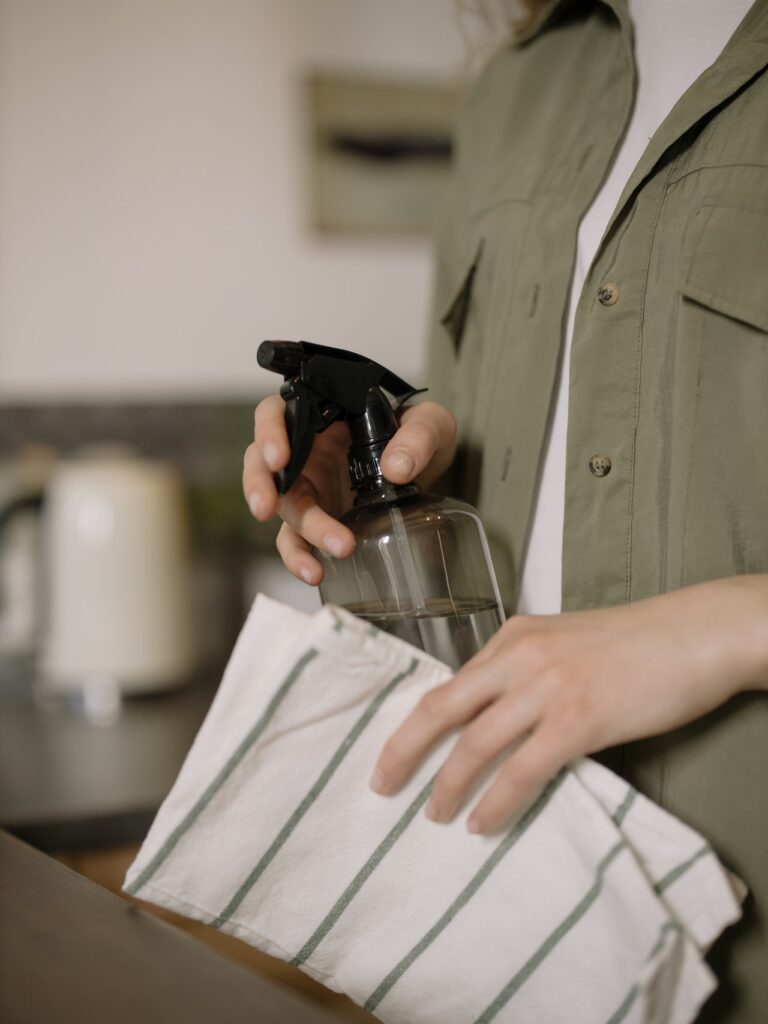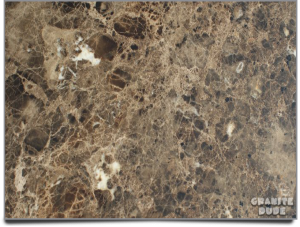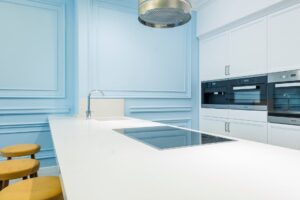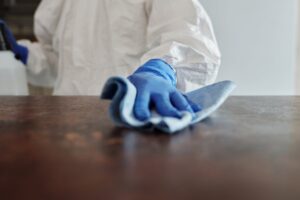Marble may be found in abundance in the lobby of any hotel that has earned the five-star designation. This stunning natural stone is used extensively throughout the entire building, from the ground to the walls and ceiling. The veins of marble, which are different colors, become more visible with each step you take as soon as you enter the establishment and as you make your way to the grand reception. As you stroll over the shiny floor of the hotel, you may see a mirror of yourself. And as you make your way to the sophisticated marble counter, you picture having the same slab installed in your home’s cooking space.
You are aware of the fact that you have the desire to possess one.
How to Remove Stains From Marble Countertop
Marble is a popular material for kitchen countertops for several reasons, including that it is stunning, classic, and will never appear out of date. On the other hand, marble has well-deserved notoriety for being a high-maintenance material. Marble is a relatively ductile and porous stone; as a result, it can quickly become stained, and acids such as lemon juice can erode its surface.
If you spend the money on a beautiful marble countertop, you will need to educate yourself on the proper technique to clean marble and make it a habit to give it a quick wipe down every day. After that, the best way to extend the life of marble is to dry up any spills as soon as they happen.
Marble is undoubtedly one of the most elegant and aesthetically pleasing materials you may use in your home. This excellent natural stone has been a reputation for being a symbol of elegance for a long time. The substance has been utilized in producing a wide variety of items, ranging from marble countertops to some of the most well-known statues in the world.
Additionally, the natural beauty that the stone possesses is a significant part of the reason why homeowners want to work with it so frequently. On the other hand, marble is a porous material, meaning that liquids and stains have an easier time penetrating its surface. It is even though marble’s many excellent qualities. This article will educate you on the various colors that can develop and the multiple methods on how to remove stains from marble countertops.
What to Do with Spills on Marble
Marble is among the most porous natural stone materials that are accessible to be used in construction. With this in mind, you are obliged to wipe up any spills that occur instantly. If you keep them sitting on the surface for an extended period, the marble may experience damage that you cannot repair. However, if you respond immediately, you can prevent such problems from occurring. Use a clean, moist, soft cloth to wipe the spill.
Stains and Marks on Marble Countertops
It is not the end of the world if merely cleaning up the spill does not remove the stain, as there are other ways to remove marble countertop stains. As discussed previously, spiraling proactive is essential in preventing damage caused by colors. To successfully remove the paint from your marble, however, you will first need to identify the sort of stain that has been left behind.
What Kinds of Marks Can Be Made on Marble?
In this guide, we will discuss eight typical stains that may be seen on marble countertops and other marble surfaces. These spots are called:
- Oil-based stains
- Natural discolorations
- Rust stains
- Water leaves behind stains.
- Traces of mold
- Ink stains
- Etch markings
- Paint stains
- Oil-based stains
Cooking oil, grease, milk, butter, hand lotion, and other everyday household items can leave behind oil-based stains on fabrics and other surfaces. In most cases, people will describe the hue of these stains as light brown or yellow.
Natural discolorations
On marble surfaces, organic stains are among the most common types. Examples are the rings left behind by coffee cups and other everyday items found in the home. The color of the stains might range from light brown to very dark brown.
Rust stains
If you forget to remove some items from your marble surfaces, you may have rust stains. Some examples of these items include nails, screws, and metal cans. Rust often leaves behind a color that is copper or brown in hue.
Water leaves behind stains.
Another type of discoloration that frequently appears on marble is caused by water. These stains may have been caused by a water glass left on a marble countertop for an excessive amount of time, or they may have been caused by the accumulation of hard water around sinks and showers.
Traces of mold
Mold growth is an issue that may be seen in many different types of bathrooms. Marble bathroom countertops, floors, and other surfaces can become discolored if mold is present.
Ink stains
Ink can leave stains on various surfaces, including marble countertops and other surfaces. Pens, highlighters, markers, and even alcohol can all leave behind stains that seem like ink. Typically, the colors are either water-based or alcohol-based.
Etch markings
Acidic compounds are one of the worst adversaries that marble may have. Various substances, including wine, lemon juice, and orange juice, can cause etching in marble. The top layer of the marble has worn away due to the stain, resulting in the formation of etch marks.
Paint stains
Last but not least, marble surfaces are susceptible to having paint stains on them. In most cases, the color of the stain will be identical to that of the paint used to create it. The extent of the stain will determine how challenging it will be to get rid of it.
What Methods Are There for Cleaning Marble of Stains?
You can remove the majority of stains on marble countertop by employing a homemade product known as a poultice. A poultice is a heavy paste that can be used to remove stains from marble by drawing out the color. In the following paragraphs, we will explore how each stain described before can be eliminated.
Oil-based stains
Poultices are effective at removing oil-based stains. Mineral spirits are going to be an ingredient in the concoction that will be used to make this particular poultice.
Natural discolorations
A poultice can be used to remove organic stains from fabric. The hydrogen peroxide concentration in this poultice will be 6 percent. Be very careful when trying to remove a stain from a deeper-colored marble using hydrogen peroxide because it can lighten the marble.
Rust stains
Rust stains are typically easy to remove using a poultice or a rust remover that does not contain acid. However, removing rust stains from marble is the most challenging task of all the types of colors that can occur on marble. If you have tried all these different approaches but are still unsuccessful, you should speak with an expert about the issue.
Water leaves behind stains.
Marble is relatively easy to clean when it has been stained by water. You have two options for cleaning the stain: use a standard marble cleaner or use steel wool of grade 0000.
Traces of mold
Utilizing a product like this one, created expressly to remove mold and mildew stains on marble countertop, is the most efficient method for dealing with mold stains.
Ink stains
To remove any ink stains, you can use a poultice created with hydrogen peroxide at a concentration of 6%, just as you would with organic pigments.
Etch markings
Etch marks can be removed from marble using a poultice, just like many other types of stains common on marble.
Paint stains
It is possible to use lacquer thinner to remove paint spots that are not too severe. For more severe paint stains, you should seek the advice of a professional to identify the best way to proceed.
If you are unable to eliminate the stain, what are your options?
There’s no need to freak out if the poultice doesn’t work at first. If this is the case, you should try applying it once again and waiting before proceeding. If the stain is still not removed after using the solution, you should consult a specialist to determine the most effective next steps.
What to Avoid When Trying to Remove Stains from Marble Countertop
When attempting to remove stains from a marble countertop, the last thing you’d want to do is do any additional harm to the stone. To prevent this, you should never try removing the stain using bleach or any other harsh cleanser. Any product that has an acidic pH can be considered a powerful cleaning. Using cleaners such as these might cause the surface of the marble to become pitted and worn.
What Steps Can Be Taken to Prevent Stains on Marble?
Even though marble is among the most porous materials you will come across, you can take a significant measure to reduce the risk of it becoming stained: sealing. If you close your marble countertop or any other surface, the pores will shut up, and you won’t have to worry about liquids or stains penetrating the surface. Bear in mind that you cannot guarantee the permanence of this seal. In most cases, you need to reseal marble once every several months to keep it in good condition.
How do you put a finish on marble?
The method of sealing marble is not at all difficult to complete. To get started, make sure the surface is clear and clean. After that, put on the sealer. You may need to apply the sealer with a brush if it comes in that form, or you may be able to spray it on if it comes in a bottle. It will depend on the product. To protect your marble, use the sealer. Make sure that the entire surface is covered.
After this, you will need to watch the sealer for the following fifteen minutes. If the sealer is completely absorbed within the allotted time frame of 15 minutes, you should apply a second coat. After the allotted time has passed, remove any excess sealer from the marble surface and wait twenty-four hours.
What Other Useful Information Ought You to Be Aware Of?
Ensure that you maintain a consistent cleaning and resealing schedule so that stains do not become an issue. You will likely not have to deal with stains if you perform these two straightforward actions first. Even though cleaning stains can be a simple project for you to tackle on your own, it is not something you will want to perform regularly. In addition to periodic cleaning and resealing of marble surfaces, you should also exercise extreme caution around them.
Marble is undoubtedly one of the most stunning materials you could choose to decorate the interior of your home. There is a wide range of colors and textures, including stark whites, deep browns, and even black marble. Moreover, marble is a stunning representation of the natural beauty that can be produced. Take care of this magnificent natural stone the way it should be. It will continue to benefit you for many years in terms of its look, durability, and a wide variety of other desirable attributes.
Marble countertops offer a level and smooth surface that is great for various culinary preparations, such as peeling and chopping vegetables. It is ideal for utilization in the kitchen regularly and performs exceptionally well when adequately sealed.
Marble as an Ideal Countertop Material
There is something about the timeless nature of marble as a countertop material that imparts a sense of class and refinement wherever it is used.
You can find the precious stone in various colors, including milky white, chocolate brown, coal black, salmon pink, and emerald green. Because there is such an extensive variety of alternatives, we are confident that you will be able to choose a countertop piece that is complementary to the design of the rest of your kitchen.
In addition to that, it has excellent heat resistance. In contrast to solid surfaces or quartz, marble countertops can withstand the heat from hot pots and pans quite well.
Even though it is possible to prevent stains from occurring, assuming the situation is hopeless is not necessary if they do. You may quickly restore the marble’s pristine appearance by carefully following the procedures outlined above. Taking good care of this stunning stone is essential if one wishes to preserve it for future generations. If you follow these steps, you will have a marble countertop that satisfies your needs.
When given the appropriate attention and care, the marble surface in your kitchen can last for decades if properly maintained.








